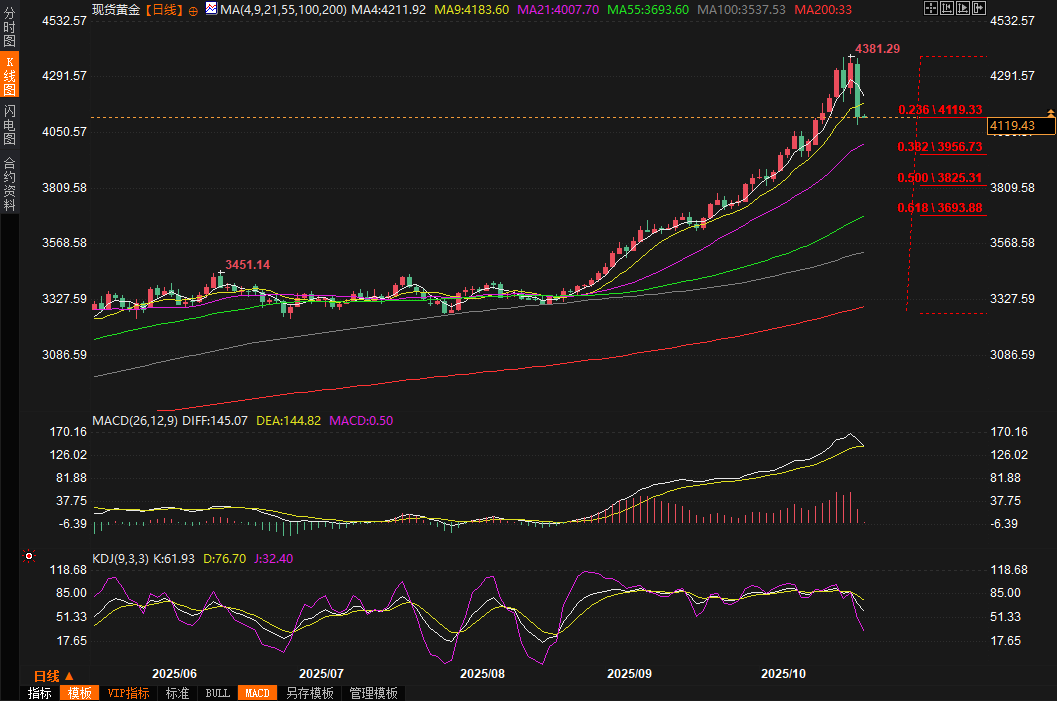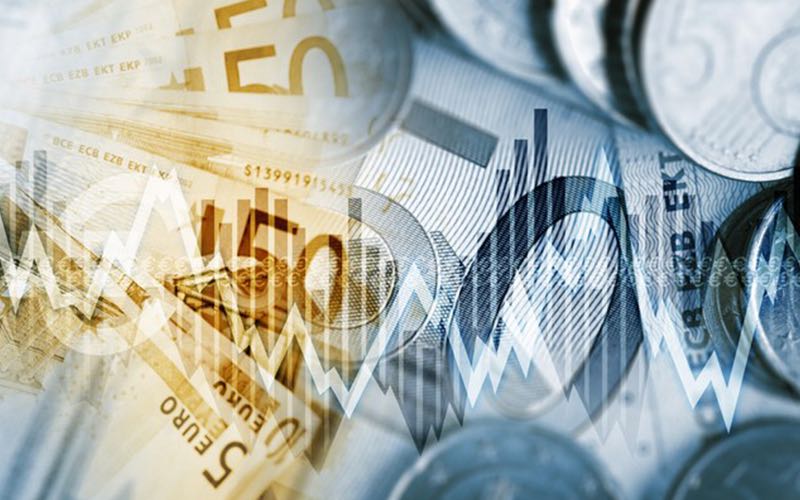Gold trading reminder: Gold prices plummeted by nearly $300, marking the largest single-day drop in five years. Is the safe-haven myth shattered or a new opportunity emerging?
2025-10-22 07:09:18

The direct cause of the gold price plunge: profit-taking and the decline of risk aversion
The sharp drop in gold prices stems primarily from investors collectively taking profits at high levels. Gold's strong rally this year has been fueled by multiple factors: geopolitical uncertainty, continued buying by global central banks, and strong expectations of a Federal Reserve rate cut. These factors have combined to push gold prices to record highs, but they have also accumulated a significant amount of speculative positions. At the slightest shift in market sentiment, bulls have begun selling to lock in profits. Independent metals trader Tai Wong noted that while gold prices continued to see bargain hunting on Monday, the surge in volatility from high levels over the past week has signaled caution, further encouraging short-term profit-taking.
Meanwhile, a short-term weakening of safe-haven demand has become another key factor weighing on gold prices. Recent signs of optimism in the international trade situation, particularly US President Trump's positive comments about reaching a trade agreement with his Chinese counterpart, have eased market concerns about a trade war. Furthermore, expectations of a possible end to the Russia-Ukraine conflict have also reduced gold's safe-haven appeal. Despite reports from the Russian Ministry of Defense that its forces attacked Ukrainian energy facilities and shot down 55 Ukrainian drones, resulting in four deaths and four injuries in the Chernihiv region of Ukraine, Trump expressed continued confidence in the possibility of a ceasefire agreement between Russia and Ukraine and planned to issue a notice on the situation within the next two days. This series of news has tempered investors' assessment of geopolitical risks, weakening gold's appeal in the short term.
Kitco Metals senior analyst Jim Wyckoff emphasized in the report that the overall risk appetite in the market improved at the beginning of this week, which posed a clear negative impact on safe-haven metals.
Domestic political dynamics in the United States also played a significant role. The three-week federal government shutdown delayed the release of key economic data, such as the September Consumer Price Index (CPI) report, adding to market uncertainty. However, news that Democratic leaders Chuck Schumer and Hakeem Jeffries proposed meeting with Trump before his Asia trip to discuss healthcare subsidies and end the shutdown injected a sliver of optimism into the market. Kevin Hassett, director of the National Economic Council, also suggested the shutdown could end this week. These developments further reduced safe-haven demand, pushing gold prices lower.
The impact of a stronger US dollar and global monetary policy
Gold price fluctuations are often closely linked to the US dollar, and this plunge is no exception. On Tuesday, the US dollar index rose 0.34%, hitting a six-day high of 98.98, making gold more expensive for investors holding other currencies, thereby suppressing demand.
The dollar's strength stems in part from political change in Japan: the yen slumped to a one-week low after the election of hawkish conservative Sanae Takaichi as Japan's first female prime minister. Investors are betting her government could expand fiscal easing and complicate the Bank of Japan's path to rate hikes, further supporting the dollar.
Fred Neumann, chief Asia economist at HSBC, analyzed that from a political perspective, Japan may postpone monetary tightening until fiscal easing takes effect, which puts the Bank of Japan in a dilemma.
The broader monetary policy environment is also unfavorable for gold. ECB Executive Board member Philip Lane warned that eurozone banks could face dollar funding pressures, highlighting global liquidity concerns. Meanwhile, Trump's pressure on the Federal Reserve and expectations of rate cuts continue to simmer. U.S. bond market data showed a decline in Treasury yields, with the 10-year bond yield falling to 3.961%, the 30-year to 4.546%, and the two-year to 3.455%. The yield curve continued to flatten, with the spread between the two- and 10-year yields narrowing to 50 basis points, the flattest since September 17. This typically signals lower investor expectations for inflation and signals a potential Fed rate cut.
A Reuters poll showed that economists unanimously predicted the Federal Reserve would cut interest rates by 25 basis points at its October 28-29 meeting, lowering the federal funds rate range to 3.75%-4.00%, and cut rates again in December. The futures market has fully priced in two more rate cuts this year and is even pricing in three more rate cuts in 2026.
These rate cut expectations should have been bullish for gold, but in the short term, the market is more focused on delayed inflation data and a weak job market. The survey median forecast predicts the unemployment rate will remain around 4.3% until 2027, while inflation (measured by personal consumption expenditures) is expected to remain above 2% annually, above the Fed's 2% target. The September CPI, due for release on October 24th, is expected to rise to 3.1% from 2.9% in August. Gregory Faranello of AmeriVet Securities said that while the market is hesitant to bet on a rapid rate cut in the absence of sufficient data, the overall interest rate market remains firm, and the flattening yield curve is consistent with expectations of further lower rates. Vinny Bleau of Raymond James added that even with short-term economic growth, the bond market still has room to rebound, with the 10-year Treasury bond potentially falling to 3.60%-3.70%.
Silver linkage and the chain reaction of precious metals market
Gold's plunge wasn't isolated. Silver prices also plummeted 7% on Tuesday, closing at $48.62 per ounce, dragging down the entire precious metals sector. Spot platinum and palladium both fell over 5% on Tuesday. Tai Wong analyzed that silver's short-term ceiling is $54, and market sentiment is fluctuating below $50. As long as gold prices remain relatively strong, silver is likely to maintain significant volatility. However, gold's current weakness has undoubtedly exacerbated silver's volatility. Citi analysts noted in a report that expectations of an end to the US government shutdown and a US-China trade agreement are likely to cause gold prices to consolidate over the next two to three weeks, which will also affect related assets such as silver.
Furthermore, Trump's comments on the situation between Russia and Ukraine have added to uncertainty. He expressed his unwillingness to engage in a "meaningless meeting" with Putin and reiterated his call for a freeze on the current front as part of a ceasefire agreement, a proposal rejected by the Kremlin. White House officials confirmed that Trump has no immediate plans to meet with Putin, suggesting that a second summit is uncertain. While Trump expressed hope for a ceasefire, his overall assessment of the conflict was relatively pessimistic, which could further impact global risk sentiment. Sources revealed that Russia reiterated its peace terms in diplomatic communications over the weekend. While these geopolitical factors did not directly trigger the sell-off, they reinforced the market's short-term caution regarding safe-haven assets.
Future Outlook: Consolidation or Rebound?
In summary, the largest single-day drop in gold prices in five years was driven by a combination of profit-taking, waning risk aversion, a stronger US dollar, and monetary policy expectations. In the short term, gold prices may enter a period of consolidation, with a Citigroup report predicting continued volatility over the next two to three weeks. However, in the medium to long term, the foundation for this year's 60% gain remains solid, with geopolitical uncertainty, the risk of an economic slowdown, and central bank buying demand continuing to support gold. A Reuters poll showed that the Federal Reserve's interest rate path for next year remains unclear, with a wide range of forecasts, ranging from 2.25%-2.50% to 3.75%-4.00%, increasing policy risks. Deutsche Bank's Brett Ryan warned that the risk of the Fed losing its independence is heightened, and uncertainty about who will succeed Powell after his term ends will also exacerbate volatility.
For investors, this plunge may present a buying opportunity, but they should be wary of potential impacts from inflation data and the Federal Reserve meeting. While gold's safe-haven myth may have been temporarily shattered, its core value as a hedge remains unchanged. Amidst continued global uncertainty, a rational allocation to gold assets may be a wise choice to weather future storms.

(Spot gold daily chart, source: Yihuitong)
At 07:07 Beijing time, spot gold was trading at $4119.64 per ounce.
- Risk Warning and Disclaimer
- The market involves risk, and trading may not be suitable for all investors. This article is for reference only and does not constitute personal investment advice, nor does it take into account certain users’ specific investment objectives, financial situation, or other needs. Any investment decisions made based on this information are at your own risk.





















